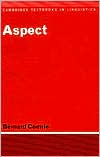Aspect: An Introduction to the Study of Verbal Aspect and Related Problems
An introduction to the general linguistic study of aspect. Topics covered include the relation of tense and aspect, the morphology and the semantics of aspect, and structuralist and philosophical approaches. Dr Comrie draws his examples particularly from English and the Slavonic and Romance languages, but also from Arabic, Chinese, Welsh, Greek and a variety of others. This is the first study of aspect, considered as a general linguistic phenomenon. It is intended for students of individual...
Search in google:
An introduction to the general linguistic study of aspect.
PrefaceviiAbbreviationsixIntroduction10.1Definition of aspect10.2Meaning and form60.3Terminology110.4Structure of the book130.5General reading141Perfective and imperfective161.1Perfective161.1.1Definition of perfectivity161.1.2Perfectivity and other aspectual values211.2Imperfective241.2.1Habitual261.2.1.1Habitual and other aspectual values301.2.2Progressive322Aspect and inherent meaning412.1Punctual and durative412.2Telic and atelic442.3State and dynamic situation483Perfect523.1Types of perfect563.1.1Perfect of result563.1.2Experiential perfect583.1.3Perfect of persistent situation603.1.4Perfect of recent past603.2Perfect and other aspects613.3Prospective aspect644Aspect and tense664.1Perfective, present, and future664.2Aspectual distinctions restricted to certain tenses714.3Narrative Present734.4Combined tense/aspect oppositions784.5Aspect and time reference in tenseless languages824.6Aspect and voice845Formal expression of aspectual oppositions875.1Morphology of aspect875.1.1Prefixing in Balto-Slavonic, Georgian, and Hungarian885.1.2Combined tense/aspect morphology945.2Syntactic expressions of aspectual oppositions985.2.1Locative expressions of aspectual oppositions985.2.1.1Progressive and imperfective aspect985.2.1.2Contingent state1035.2.1.3Direction and aspect1065.2.2Perfect as present plus past1065.2.2.1Perfect and inferential1086Markedness1116.1Markedness and semantics1126.2Markedness and morphology1146.3Neutralisation1166.4Markedness and frequency1166.5Markedness and context1186.6Degree of markedness122Appendix ALanguage guide123A.1Genetic classification of languages cited123A.2Aspectual systems of individual languages124A.2.1English124A.2.2Slavonic (Russian, Bulgarian, Old Church Slavonic)125A.2.3Romance (French, Spanish)126A.2.4Greek (Ancient Greek, Modern Greek)127A.2.5Chinese (Mandarin)128A.2.6Other languages (Turkish, ChiBemba)128Appendix BRecent approaches to aspect129B.1Localist theory of aspect129B.2Feature analysis130B.3Model-theoretic semantics132References134Index139








